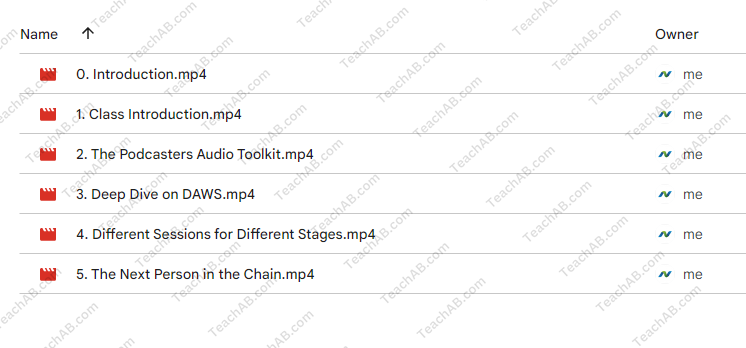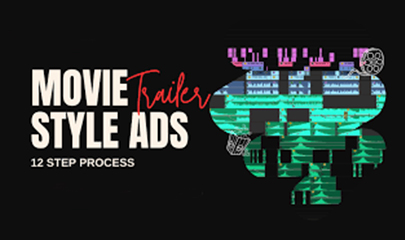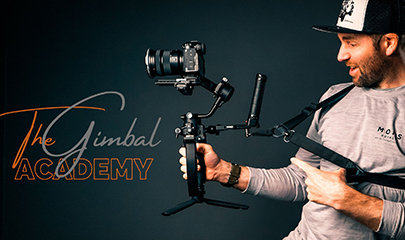Post-Production Workflows for Podcasters By Jim Briggs
$14,00 $5,00
Post-production workflows for podcasters: A review by Jim Briggs – Digital Download!
Let’s embark on a captivating adventure to uncover remarkable insights that spark your curiosity and elevate your understanding

Post-Production Workflows for Podcasters By Jim Briggs
Overview

Post-production workflows for podcasters: A review by Jim Briggs
When it comes to crafting a captivating podcast, the journey doesn’t end with recording. Just as an artist doesn’t consider a canvas complete until the final brush strokes are applied, podcasters must navigate the intricate world of post-production to ensure that their raw recordings transform into polished pieces that resonate with audiences. Luckily, Jim Briggs’ comprehensive online course, “Post-production workflows for podcasters” on CreativeLive, serves as a guiding star for both novice and seasoned creators, illuminating essential practices that streamline the often convoluted post-production processes.
Briggs eloquently addresses the myriad of challenges podcasters face after hitting the ‘stop’ button on their recording devices. With a focus on enhancing audio quality, he delineates not just what needs to be done, but also how to do it efficiently and effectively. By examining the intricacies of planning, editing, and publishing, podcasters can turn raw audio into cohesive narratives that both captivate and engage listeners. This exploration into post-production is not merely about cutting out mistakes or adding filters; it’s about creating an emotional experience that reverberates with the audience long after the episode concludes.
The importance of an organized workflow
An organized workflow is akin to a well-orchestrated symphony; it ensures that each element plays a part in creating harmonious results. In “Post-production workflows for podcasters,” Jim Briggs underscores the significance of a clear structure that encompasses all stages from conception to promotion. A key takeaway from his teachings is how an organized workflow elevates not only the quality of individual episodes but also the overall podcasting journey.
Key components of a successful workflow include:
- Planning: Sketching out content and structure before recording. This sets the stage, much like a screenplay for a film.
- Recording: Capturing clear and high-quality audio to minimize editing time later. Imagine sculpting from a block of marble; the cleaner the initial cut, the less chipping away is required.
- Editing: Utilizing tools and techniques to refine audio. This is where the artistry comes into play selecting the right moments, adding effects, and ensuring fluid transitions.
- Publishing: Strategically releasing episodes while harnessing SEO practices to reach a broader audience.
- Promoting: Creating campaigns that entice existing and potential listeners to engage with the content.
By approaching podcasting as a project with well-defined stages, podcasters can effectively allocate their time and resources, minimizing frustration and maximizing creativity.
Effective audio editing and mixing techniques
With the rise of podcasting as a medium, the demand for exceptional audio quality has never been higher. Jim Briggs dedicates a significant portion of his course to imparting effective audio editing and mixing techniques that can transform mere recordings into professional-grade episodes. The realm of audio editing is vast and often daunting, akin to a labyrinth with hidden pathways awaiting discovery.
Some essential editing techniques discussed in the course include:
- Noise Reduction: Employing tools to minimize background noise and enhance audio clarity. This creates a more pleasant listening experience, akin to clearing the clouds to reveal a bright blue sky.
- Equalization (EQ): Adjusting frequency levels to ensure each voice and sound element occupies its unique space in the mix. This is comparable to arranging a bouquet of flowers, where the unique colors complement each other without overshadowing one another.
- Compression: Balancing dynamic range to ensure consistent volume levels throughout the episode, preventing abrupt fluctuations that can jar listeners. Think of this as the invisible hand that gently guides the listener through the auditory landscape.
- Adding Sound Effects and Music: Using audio libraries to layer in ambiance, enhancing storytelling and engagement. Properly placed sound effects are like spices in cooking they elevate the overall experience when used judiciously.
These techniques, while powerful, require practice and patience. Briggs encourages podcasters to experiment with different methods and find their unique voice, ultimately leading to a signature style that listeners will come to recognize and appreciate.
Tools and strategies for a smoother post-production experience
In the digital age, the tools available for podcasters are as diverse as the genres they represent. Briggs guides aspiring podcasters through a myriad of options, highlighting how the right toolkit can dramatically streamline the post-production process. While the sheer volume of choices may feel overwhelming like standing in front of an expansive buffet Briggs helps participants identify which tools resonate with their specific needs and goals.
Some notable tools and strategies discussed include:
- Audio Editing Software: Programs such as Audacity, Adobe Audition, and GarageBand offer distinct functionalities and user experiences. Selecting the right software is similar to choosing a stage each offers its unique backdrop for the performance.
- Templates and Presets: Utilizing pre-configured templates for different episode formats. This can save a significant amount of time and effort, allowing creators to focus more on creativity.
- Collaboration Tools: Platforms like Trello and Google Drive facilitate remote teamwork, enabling hosts, editors, and marketers to collaborate seamlessly, thus breaking down geographic barriers.
- Audio Hardware: High-quality microphones and headphones play a vital role in ensuring the best input and monitoring. Just as athletes carefully select their gear, podcasters must invest wisely in hardware to achieve optimal results.
By familiarizing oneself with these tools and strategies, podcasters can work more efficiently, reclaiming time to focus on the creative aspects of their content rather than getting mired in technical challenges.
Balancing quality with efficiency
As much as podcast creators aspire for flawless audio quality, the reality is that post-production can often be a time-consuming endeavor. Briggs provides insightful advice on striking a balance between quality and efficiency, navigating the tightrope that many podcasters walk between delivering polished content and meeting deadlines.
Key considerations include:
- Time Investment: Editing one episode can take hours, yet it is crucial to gauge how much time is feasible for individual projects. Setting realistic time limits based on episode length and complexity can prevent burnout.
- Prioritizing Key Areas: Not every segment requires the same level of refinement. Identifying areas that require extra attention versus sections that can be edited quickly is an invaluable skill.
- Post-production vs. Live-mixing: Exploring the trade-offs between extensive post-production and live-mixing sessions. While live-mixing can provide immediacy, it often lacks the polish of well-edited podcasts.
Through thoughtful exploration of these elements, podcasters can evolve their workflows over time, adapting to both personal preferences and audience expectations as they grow.
Conclusion
Jim Briggs’ course “Post-production workflows for podcasters” serves as a beacon of knowledge in the expansive ocean of podcasting. By thoroughly exploring the intricacies of post-production workflows, he equips podcasters with not only essential techniques but also the confidence to navigate the often bewildering landscape of audio editing, mixing, and publishing.
Through a combination of organized workflows, effective audio editing strategies, and the right tools, podcasters are empowered to elevate the quality of their content, engaging audiences and fostering meaningful connections. As creators embark on their podcasting journeys, they will find that with dedication, creativity, and the right knowledge, their stories can resonate far beyond the microphone, ultimately transforming their listeners’ lives.
Frequently Asked Questions:
Innovation in Business Models: We use a group purchase approach that enables users to split expenses and get discounted access to well-liked courses. Despite worries regarding distribution strategies from content creators, this strategy helps people with low incomes.
Legal Aspects to Take into Account: Our operations’ legality entails several intricate considerations. There are no explicit resale restrictions mentioned at the time of purchase, even though we do not have the course developers’ express consent to redistribute their content. This uncertainty gives us the chance to offer reasonably priced instructional materials.
Quality Control: We make certain that every course resource we buy is the exact same as what the authors themselves provide. It’s crucial to realize, nevertheless, that we are not authorized suppliers. Therefore, the following are not included in our offerings: – Live coaching sessions or calls with the course author.
– Entry to groups or portals that are only available to authors.
– Participation in closed forums.
– Straightforward email assistance from the writer or their group.
Our goal is to lower the barrier to education by providing these courses on our own, without the official channels’ premium services. We value your comprehension of our distinct methodology.
Be the first to review “Post-Production Workflows for Podcasters By Jim Briggs” Cancel reply
You must be logged in to post a review.
Related products
Arts & Entertainment
Getting Started with Watercolor & Gouache Paints By Mary Jane Begin
Arts & Entertainment
Arts & Entertainment
See Better, Draw Better: Exercises for Beginners By Kateri Ewing
Arts & Entertainment
Arts & Entertainment
Arts & Entertainment
Arts & Entertainment
Arts & Entertainment



















Reviews
There are no reviews yet.